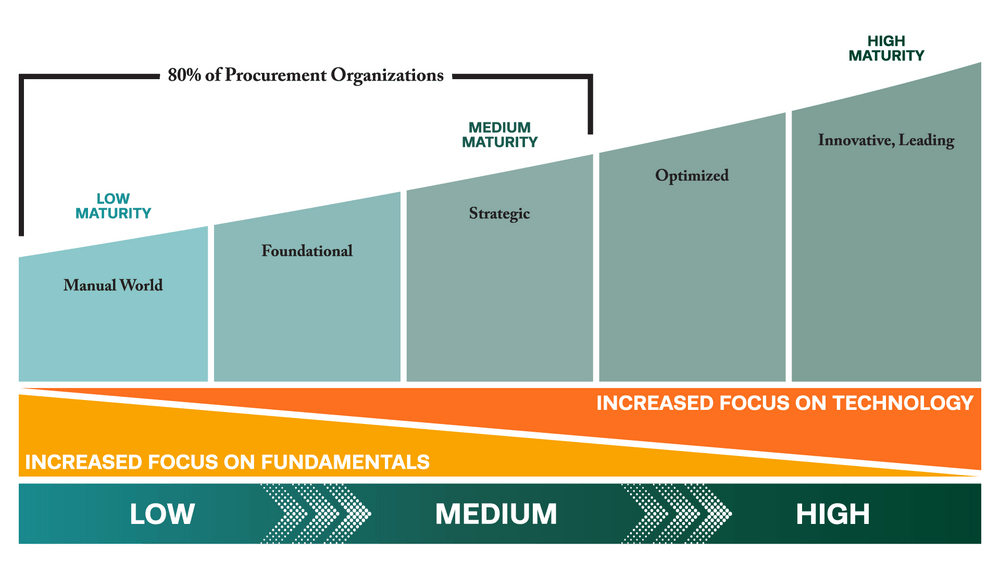TL;DR: In the face of technological disruptions like AI, what should you be focused on? Simple: mastering procurement fundamentals. Research shows that starting with a foundation of a sound procurement vision, standard processes, clean data, and a strategic skill set across your team is essential for generating outsized results. And these are also “table stakes” for the right to invest in technology initiatives. How do you know if you’ve got it? You can measure how your procurement organization measures-up with a comprehensive procurement maturity model to identify areas to work on today.
Fundamentals First, Then Innovation
“Excellence is achieved by mastery of the fundamentals.” ~ Vince Lombardi
As it was for Lombardi’s Green Bay Packers, it’s just as true in contemporary US football that teams who master the fundamentals of blocking, tackling, passing, and catching are usually more successful than their flashy and less grounded peers. Of course, I’m connecting this analogy to our procurement world, where in these times of economic and geopolitical uncertainty and disruption from AI technologies, the need to be masters of procurement fundamentals and getting back to basics is not just a cliché, it's a strategic imperative.
The procurement landscape is experiencing significant upheaval, driven in part by the swift advancement of new procurement technologies. These technologies touch all aspects of procurement. But as it pertains to the impact of these technologies on procurement people, they may be generalized as:
- technologies that are automating and eliminating more tactical and operational processes like procure-to-pay, process orchestration, and data processing. Here, it is likely that technology will take these activities off procurement people’s plates; and
- advanced technologies that are augmenting human capabilities in the more strategic facets of procurement, including market intelligence, category management and complex sourcing. Here, technology can greatly accelerate the value that procurement can deliver if the procurement function driving them is sufficiently strategic and mature to drive them effectively.
Therefore, for procurement organizations to remain relevant and avoid extinction (as some are predicting), a shift towards more strategic capabilities, higher maturity and increased value to the business is imperative.
Procurement Maturity Modeling
Amidst this surge of digital technologies, the need to master procurement fundamentals remain steadfast, and in fact becomes amplified. We’ve seen no shortage of research from industry groups that report upwards of 70-80% of digital initiatives do not deliver the promised value, largely driven by low adoption. Often cited is the need to start with a foundation of sound processes, accessible and clean data, and strategic skill sets. In other words, procurement fundamentals. These fundamentals also encompass several important elements:
- building strong relationship management skills to align closely with business stakeholders
- evolving into a more strategic and value-generating function
- developing a comprehensive procurement vision and roadmap
- establishing category-level strategies that align with market dynamics
- driving strategic sourcing methodologies across as much spend as possible
- optimizing core processes
- developing a comprehensive data strategy
That may sound like a lot to address, but there is a useful tool to help you focus your efforts. Understanding where your organization stands in terms of procurement maturity is key to framing your focus. Maturity models serve as invaluable tools for candidly assessing all dimensions of the procurement function (people-process-data-technology, see Figure 1). Done properly, maturity models highlight key gaps and areas that need development, as well as areas of strength that can be leveraged and expanded.

Figure 1: Example High Level Maturity Model
With a clear picture of your current state and well-defined future vision & strategy, you can identify the most critical areas that are holding you back or need some focused attention to prepare you for the next stage of maturity. Procurement has made great strides over the past couple of decades, and yet today I have found that most procurement organizations (80%) fall within the Medium to Low maturity ranges. To be clear, a maturity level itself is neither good nor bad, nor does it reflect the potential value that procurement is delivering to their businesses. Rather, this is merely an indication of where most procurement organizations are in their transformation journeys. And more importantly, this helps us to identify where are the most important areas of focus that will deliver maximum value.
As you can see in Figure 2, a strong foundation in the fundamentals of procurement is critical to ensuring the success of any technology initiative, and therefore should be a leading priority for most companies.

Figure 2: Mastering the Fundamentals is Critical to Procurement Transformation
Regardless of your organization's maturity level, I will leave you with three critical success factors for all your digital initiatives:
- Focus, focus, focus on the business problem – Remember, technology itself is not an objective. Solving business problems and delivering value to your business is the objective. Narrow your focus to 1-3 areas where technology can make the greatest impact against these business objectives. Having multiple bets is a good approach when experimenting, but too scattered an approach can make it more difficult to remain focused on core business objectives.
- Master the fundamentals – As I’ve emphasized throughout, regardless of your level of procurement maturity, mastering the fundamentals is non-negotiable. Aligning with stakeholders, developing strategic visions, establishing efficient processes, and leveraging data for actionable insights are timeless practices that amplify the success of technology initiatives.
- Embrace digital technologies holistically – Don’t let your technology initiatives be a side show, with separate “technology people” running them disconnected from your procurement team. The implementation and use of digital technologies needs to permeate every aspect of your procurement ecosystem if you truly intend to digitally transform.
The journey through disruption in procurement necessitates a dual focus on embracing technology innovation and mastering the timeless fundamentals of procurement. By doing so, procurement organizations can not only survive but thrive in an era where adaptability and strategic thinking are the keys to sustained success.
About Chris Eyerman
Chris is a proven builder and grower of procurement organizational capabilities, processes, digital technologies and high performing teams. Chris held procurement and supply chain leadership roles at Denali, FreeMarkets, Ariba and Exostar across strategy, global transformation programs, new client implementations, client management and digital transformation. He is a real-life rocket scientist and holds an MS degree in Aeronautics and Astronautics from MIT as well as an MBA from Carnegie Mellon University.
About Summit Procurement
Summit Procurement enables enterprise clients to hit peak procurement performance. Our flexible managed services, staff augmentation, strategic training, and human-in-the-loop services are designed to lift procurement execution and create operational efficiency.
![[object Object]](https://umsousercontent.com/lib_EbKKUWpOITipFQSG/MBVFsxyPlozYrYGr.png?w=400)
